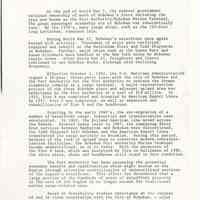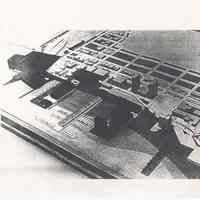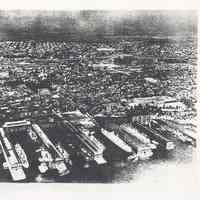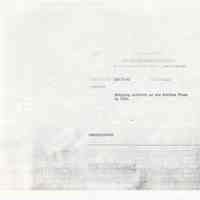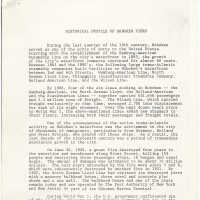Collections Item Detail
Historical Profile of Hoboken Piers. Produced by Port Authority, January 1984.
2005.079.0023
2005.079
Maier, Bob
Donation
Gift of Bob Maier.
1984
Early Create Date: 1984 Date(s): 1984 Level of Description: Item
Display Value: Fair Notes: Archives 2005.079.0023 Issued 1984. ==== HISTORICAL PROFILE OF HOBOKEN PIERS During the last quarter of the 19th century, Hoboken served as one of the ports of entry to the United States. Starting with the establishment of the Hamburg-American Steamship Line on the city's waterfront in 1863, the growth of the city's waterfront commerce continued for almost 60 years. Between 1863 and the 1890's, the following large trans-Atlantic steamship companies built facilities on Hoboken's waterfront between 2nd and 6th Streets: Hamburg-American Line, North German Lloyd Line, Thingvalla (Scandinavian) Steamship Company, Holland American Line, and the Wilson Line. By 1906, four of the six lines docking in Hoboken -- the Hamburg-American, the North German Lloyd, the Holland-American and the Scandinavian Lines -- together carried 651,646 passengers and 2.3 million tons of freight. The Wilson Line, which carried freight exclusively at that time, averaged 2.700 tons displacement for each of its eight steamers. Over the next dozen years prior to World War I, the above-mentioned lines added new steamers to their fleets, increasing both their passenger and freight totals. One of the consequences of the active trans-Atlantic activity on Hoboken's waterfront was the settlement in the city of thousands of immigrants, particularly from Germany, Holland and Great Britain, who poured off these ships. As a result, the last decade of the nineteenth century was a period of tremendous population growth in the city. On June 30, 1900, a great fire destroyed four piers to the waterline and warehouses along River Street, killing 145 people and destroying three passenger ships, 18 barges and canal boats. The amount of damages was estimated to be about 10 million dollars. The only piers untouched by the fire were piers 5 and 6, which were subsequently destroyed by another fire in 1921. By 1902, the North German Lloyd Line had replaced its destroyed piers with a masonry bulkhead house, three steel and concrete pier sheds and a sea wall. The bulkhead house and one of the piers remain today and are operated by The Port Authority of New York and New Jersey as part of its Hoboken Marine Terminal. During World War I, the U.S. government confiscated six of the 17 piers adjacent to the Hoboken Terminal for use as the chief point of debarkation for American troops going to Europe. A favorite phrase among the soldiers leaving from Hoboken was "Well, it's Hell, Heaven or Hoboken by Christmas." The city-also functioned as the point of return for the thousands of war dead and wounded. An average of 3,500 American soldiers left daily from points in Hoboken and New York City, the record daily number of troops transported from the two cities to Europe was reported to be 46,214 on August 31, 1918. ==== page 2 At the end of World War I, the federal government retained ownership of much of Hoboken's piers including the area now known as the Port Authority/Hoboken Marine Terminal. The great passenger steamship era of Hoboken was substantially over. By the 1930's, many large ships, such as the 750-foot long Leviathan, remained idle. During World War II, Hoboken's waterfront once again buzzed with activity. Thousands of ships were outfitted, repaired and rebuilt at the Bethlehem Steel and Todd Shipyards in Hoboken. Further, major ships such as the Queen Mary and Queen Elizabeth were handled at the New York docks by Hoboken repair crews. After World War II, freighters and liners continued to use Hoboken docks, although with declining frequency. Effective October 1, 1952, the U.S. Maritime Administration signed a 50-year, three-party lease with the city of Hoboken and the Port Authority for the Port Authority to operate the former steamship complex as a cargo terminal. A major reconstruction project of the three Hoboken piers and adjacent upland area was undertaken by the Port Authority at a cost of $18 million. In 1955, Pier A was completed and occupied by American Export Lines. By 1957, Pier C was completed, as well as expansion and rehabilitation of Pier B and the headhouse. Starting in the early 1960's, the out-migration of a number of waterfront cargo, industrial and transportation uses accelerated. In 1963, the Holland American Line moved across the Hudson. Several years later in 1967, the remaining ferry , boat services between Manhattan and Hoboken were discontinued, the Todd Shipyard left Hoboken and the American Export Lines transferred its cargo activity to Brooklyn. During this period, because of the lack of upland area to construct modern container-ization facilities, the Hoboken Port Authority Marine Terminal became underutilized, as it is today. With the exception of the Pier B deck, which was destroyed by fire on Halloween of 1980, the three piers, sheds and headhouse still stand in fair condition. The Port Authority has been assessing the potential economic benefit and opportunities which might accrue to the Region through selective revitalization of underutilized sections of the Region's waterfront. This effort has determined that a large portion of the hundreds of acres of waterfront property in the core of the Region is no longer needed for traditional marine cargo-related uses. Based on feasibility studies undertaken at the request of and in close cooperation with the City of Hoboken, a major waterfront area within Hoboken, has been identified as an area for mixed-use waterfront development. ==== page 3 The result of these feasibility studies points to a potential development program in Hoboken which would consist of a balanced mix of housing, office facilities, retail and consumer services, research and development facilities, marina, hotel, conference center, public access/open space uses. Other aspects of this development would include public improvements such as upgrading the Transportation Center in Hoboken at the interface of PATH and NJ Transit rail and bus services, improving roads and infrastructure, and providing for adequate parking. This potential development would create a center of lively activity and replace long stagnant and underutilized waterfront land. The development plan will be the subject of discussion by public agencies, interested groups, and the general public. It will also form the basis for appropriate environmental assessments and land use review procedures prior to actual development. Legislation authorizing the Port Authority to participate in a bi-state waterfront redevelopment program has been passed in New Jersey and is under consideration by the New York Legislature. [end of main text] ==== ==== Status: OK Status By: dw Status Date: 2005-12-16
![text pg [1]](https://d8e7jbdw4fu0e.cloudfront.net/11047/c5b2d120-fa33-11ed-a641-b3912f9925a9-uttuPAw.lg@2x.jpg)

![text pg [1]](https://d3f1jyudfg58oi.cloudfront.net/11047/image/c5b2d120-fa33-11ed-a641-b3912f9925a9-uFbcBYc.tn.jpg)
